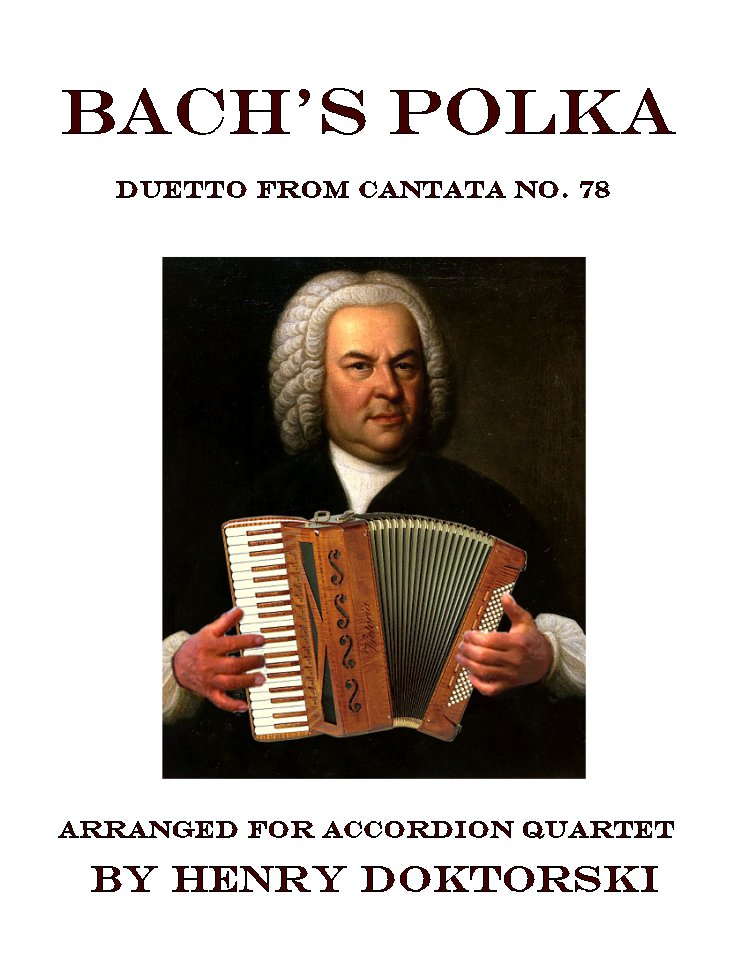Bach’s “Polka”
for accordion quartet

Includes printed conductor’s score, and individual parts, for Bach’s “Polka”—the duetto from Cantata No. 78, arranged for accordion quartet by Henry (1991, revised 2006). Duration: 4 minutes, 30 seconds.
Did J. S. Bach write the world’s first polka? This enchanting and lively dance from Cantata No. 78 was originally scored for two singers (a boy soprano and alto), and two stringed instruments (a violoncello and violone—the ancestors of the modern-day cello and bass fiddle). Henry has proved that this Baroque composition works just as wonderfully when played by four accordions.
Professionally typeset and printed. Conductor’s score spiral bound. Score = 10 pages and measures 8.5 x 11 inches. Includes parts for First Accordion, Second Accordion, Third Accordion, and Bass Accordion. Score also includes optional percussion part.
ACCORDIONIST DISCOVERS BACH “POLKA”
Published in The Polka News (St. Charles, Michigan: February 13, 1991)
Note: this is a humorous article and is not to be taken seriously.—Henry Doktorski
Wheeling, W.Va.—A West Virginia accordionist claims to have discovered a polka written by the great music master of the eighteenth century: Johann Sebastian Bach.
Concert accordionist, Henry Doktorski, said he accidentally discovered the work while studying the original manuscripts of Bach’s cantatas.
Classical music connoisseurs might be surprised that the composer of Mass in B Minor and the Passion According to Saint Matthew had also written such an earthy and scandalously sensual work as the polka. Scholars are divided as to whether the piece in question—titled simply “duetto” by Bach—is actually a polka or not.
Jan Kleeman, professor of Ethnomusicology at Brown University in Providence, Rhode Island, said that the music/dance form known as the polka first appeared in southern Poland in 1830. In other words, Bach could not have written a work in that genre, since he died eighty years before the polka was invented.
Doktorski and his supporters, however, claim that Bach, like many geniuses, was a century ahead of his time, and that it was he who actually was the original creator of that wild and breezy two-step which spread like wildfire across the globe in the 1840’s, and which still is being performed today. Historians tell us that the polka became so popular in the mid-nineteenth century that it was danced by Queen Victoria in Buckingham Palace, by American Indians in Arizona, by Africans, Russians, Australians and Indonesians. The Polka even became the national dance of Paraguay.
Hannsdieter Wohlfarth, Professor at the Musikhochschule in Freiburg, West Germany and internationally renowned Bach scholar, provides a solution to the problem of the apparent paradox of the common authorship between Bach’s inspiring religious works and his danceable “polka.”
Wohlfarth said, “Throughout Bach’s entire life, he never wavered from the conviction that his music was an act of worship, an integral element in the service of God. His works are timeless and touched by God. Yet, curiously enough, Bach made little distinction between sacred and secular music or even sacred and secular vocations. When composing secular preludes solely for his children, he prefaced them with ‘in nomine Jesus,’ just as he added ‘Soli Deo Gloria’ as a colophon to his religious scores.”
Doktorski explains the origin of Bach’s “polka” and his concealed affinity toward the dance, “While it is true that Bach was a deeply religious man, it is also true that he had a jest (zest) for life which was not always appreciated by his more conservative church leaders. He was reprimanded for letting a woman sing in the choir loft, he fathered more than twenty children and enjoyed informal parties and family gatherings where he and his musician friends and relatives would improvise songs—quodlibets—with vulgar ‘off-key’ lyrics.”
Johann Nikolaus Forkel, Bach’s first biographer, wrote in his treatise on Bach’s life, “They sang popular songs, the contents of which were partly comic and partly naughty. . . and not only laughed heartily at it themselves, but excited an equally hearty and irresistible laughter in everybody that heard them.”
Doktorski theorizes that the “Polka” was born at one of these gatherings and that Bach later secretly incorporated one of his polkas in Cantata No. 78.
Doktorski said, “In his work for the church Bach may have felt restricted by the oppressive regulations imposed upon him by the Lutheran clergy. Music resembling secular dance forms were prohibited in church. Therefore, Bach sometimes had to cleverly disguise his music to pacify the clerical censors.”
Joseph Macerollo, professor of Musicology and Music Theory at the University of Toronto and the Canadian Royal Conservatory of Music (and an accomplished virtuoso concert accordionist as well), confirmed this theory: “It was common practice among Baroque composers to alter titles of their pieces when they were to be performed in church. The ‘sonata da camera’—secular sonata, and the ‘sonata da chiesa’—church sonata, were often different only in name.”

